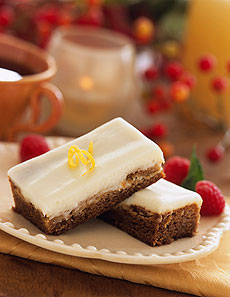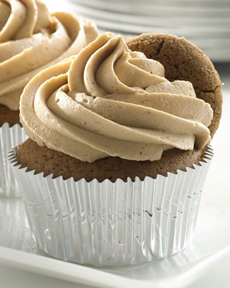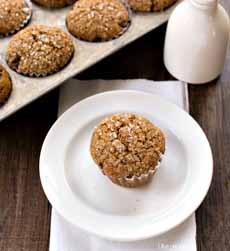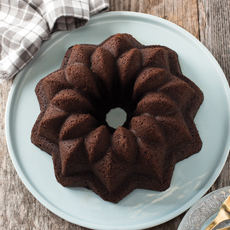Why Make Gingerbread For Summer? It’s National Gingerbread Day!
 [1] One way to celebrate: gingerbread bars with cream cheese frosting. Here’s the recipe (photo © McCormick).
|
June 5th is National Gingerbread Day. But isn’t gingerbread a winter holiday food?
It became that way, only because the spices were so costly in medieval Europe, that most people only sprang for them to celebrate Christmas. Because the spices are…well…spicy, i.e. heat-generating, they are also called warm spices, which became associated with the colder months. But just as you can roast a turkey in July or have ice cream in December, most recipes work year-round (with an aside, to underscore the benefits of choosing fruits and vegetables seasonally). Ginger-spiced cookies, cupcakes, and other baked goods fit right in with warm weather. Serve them with ice cream or frozen yogurt, iced coffee, or iced tea. Or make muffins, scones, and even gingerbread waffles. The recipes are below, as is the history of ginger. Also, check out: What we call ginger (Zingiber officinale), is the root of the ginger plant. It likely originated in the tropical lowland forests of the Indian subcontinent and southern Asia. It has been cultivated for 5,000 years, made into a tonic to treat ailments*, as well as a spice for food. The ancient Chinese philosopher Confucius celebrated its healing powers. Since ancient times, the Chinese and Indians used the ginger root as medicine. Ginger originated in the tropical rainforests of Southeast Asia. By the first century, traders had brought it to the Mediterranean via India. It became popular in the Roman Empire, where it was a symbol of wealth. The fresh roots were dried or preserved for the long voyage. After the fall of the Roman Empire in 476 C.E., ginger and other imported spices fell by the wayside during the Dark Ages. It returned with the resurgence of trade in medieval Europe. It was commonly used to make baked goods and sweets; but again, you needed the bucks. In the 14th century a pound of ginger cost as much as a sheep! Still used medicinally in medieval times, ginger became a popular holiday spice (it was too pricey to use year-round), most famously in gingerbread cookies. In 11th-century northern European countries, it was used to flavor buttermilk drinks and over the next two centuries became used in cooking meats and in ginger pastes. Ginger and other spices were brought back to Europe by Crusaders who traveled to the Holy Land. In 11th-century northern European countries, it was used to flavor buttermilk drinks and over the next two centuries became used in cooking meats and in ginger pastes. During the 13th and 14th centuries, Arabs traders voyaging to Africa and Zanzibar planted the rhizomes, spreading the cultivation of the plant. |
|
|
In the 15th century, ginger was planted in the Caribbean, where it could more easily be brought to Europe. It was also planted in Africa. Today ginger is grown throughout the tropics. Many ginger-flavored baked goods have evolved since then, from muffins to cakes (not to mention lattes and frozen yogurt). ________________ *Among other things, the volatile oils in ginger, gingerols and shogaols, help with digestion, gas and cramping; relieve nausea; help to reduce inflammation and fever; help prevent blood clots; make ginger a natural decongestant and antihistamine and may also help lower LDL cholesterol. CHECK OUT WHAT’S HAPPENING ON OUR HOME PAGE, THENIBBLE.COM. |
||





